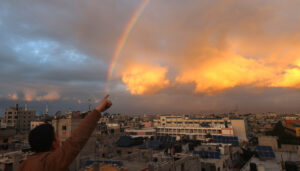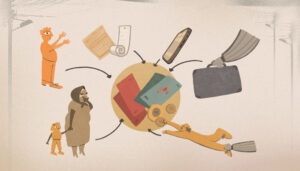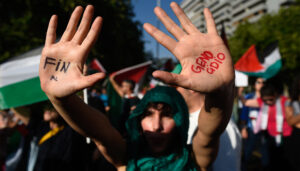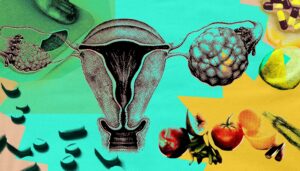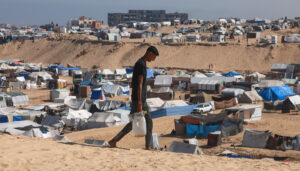
“In my opinion, the olive tree is the symbol of peace. The trees are as old as time, and are absolutely delightful; you can walk around it smell it and rest under it. To the people, they are everything.” – Mahmoud Twaissi, Mapping Coordinator, Abraham Path Initiative
A project to create a path that connects many of the places and paths that Abraham once traveled; an ambitious and provocative project that hopes to bring the peoples of the world around a uniting piece of history: Abraham himself.
Father of (Half) of Humanity
Many know him as the father of the three major monotheistic religions and roughly half the people on the world are his descendants. This is a powerful tradition that some hope to create into a tourist destination that rivals the Inca Trail, Camino a Santiago de Compostela and the Grand Radonnee.
The Abraham Path Initiative, founded at the Global Negotiation Project at Harvard University by William Ury, strives to honor all peoples, faiths and cultures. Despite this utopian goal, the project is a well-funded non-governmental organization (NGO) that has received endorsements from various heads of states in the region, Nobel Laureates, and the United Nations’ Alliance of Civilizations.
According to Ury, the time for the Abraham’s path to be re-born is now. His fondness of saying “less talk, and more walk” is a light-hearted reminder that the work has just begun.With the trail eventually leading from Abraham’s disputed birthplace, Sanliurfa (pictured above right) in South-Eastern Turkey, through Syria and Jordan, leading to the undisputed burial of Abraham, in Al Khalil or Hebron in the Occupied Palestinian Territories.
The trail is still being developed and more than 80 KM in Jordan have already taken the form of a rough trail through ancient olive grooves, beautiful ruins, and small agricultural towns.With the goal to make the world a better place through the development of tourism, the ambitious project is certainly making some progress although a number of concerns remain.
Is tourism the answer?
What does this mean for the communities along the path? Will the trail bring tourism and an influx of money, or will it bring culturally insensitive tourists, their polluting buses and stretch their already stretched resources in the name of 5-star hotels?
Here in Jordan, we’ve seen more than our fair share of initiatives promising economic development at the expense of the local population, agreements that have gone uncompleted and promises unfulfilled. With good reason, we are skeptical of another initiative promising to make the world a better place.
During a dedicating ceremony in Sanliurfa, Turkey, I posed these questions to Mahmoud Twaissi, a mapping coordinator for the Abraham Path Initiative in Jordan. Many speeches were given expressing everything the Abraham Path could become, and now I wanted to hear from someone on the ground, working on the project.
Firsthand look
Mahmoud is a short guy, but don’t let his wiry appearance deceive you; he sports a captivating personality that draws you into his words and makes you want to join his side. His raw energy is nice change from a conference filled with well-rehearsed personalities and well-heeled suits.
As if predicting my first question, Mahmoud begins to justify the project in Jordan.
“In Jordan, tourism is something that we rely on. The numbers have been increasing, but there is a need for additional tourist products – hiking, eco-tourism – more diversity of products,” says Mahmoud.
He continues, “Jordan has numerous sites ranging from nature, to ancient shrines that haven’t been developed or uncovered. But most importantly, we are one of the best resources of Jordan: the people.”
Not For Everybody
The trail promotes contact with the local population as a mutual, symbiotic relationship where foreigners are able to discover the hospitality, traditions, and histories of local peoples. In return, the local peoples are supposed reap the benefits of additional tourist monies being pumped into rural areas that rarely see tourists.
Depending on who you ask regarding the Bedu who once lived in Petra, the arrangement has worked both wonderfully and terribly. Some argue that Petra is a tourist opportunity that has been more successfully taken advantage of by Israel. Many tourists cross into Jordan from Israel for a day or two to see Petra and Wadi Rum.
As many at the conference have said, the key to tourism is the number of nights the tourist stays.
Mahmoud suggests that with the Abraham Path in Jordan, the number of nights a tourist stays in Jordan could increase substantially leading to more economic development.
Mahmoud, while well-versed in the impact of tourism on the economy, is more interested in the path becoming “an open museum and open university” where everyone in the world can come to Jordan and learn about the history and appreciate the remarkable beautiful of, what many in the West view as a bland and empty desert.

In developing the trail, Mahmoud has worked closely with Daniel Adamson, a feisty English man that looks much more comfortable wearing a keffieyeh around his neck that wearing a tie. Together, these two men have mapped about 80 kilometers with a soviet-era jeep and the latest GPS tools. Their adventures have lead them to discover some of Jordan’s more precious hidden and unknown cultural heritage site.
“We are focusing on the contours and topography of the land. We’ve linked the trail through historically interesting sites and beautiful wadis (valleys). Many of these sites are covered with rocks and rubble,” Mahmoud continued, suggesting that these sites should be developed and could potentially lead to a tourist site.
Importance of Olive Trees
“The olive trees are important to the people because the trees have many ties with history and religion. Some people think Jordan is new. Most of the villages have old olive trees that are 1,000 years old,” explains Mahmoud.
Anyone that has traveled in the region has seen the olive groves on the hills. Mahmoud leaves no doubt that the olive trees are an important aspect of the land and historically important. As he talks about olive trees, Mahmoud’s face lights up and he speaks faster and more excitedly.
“In my opinion, the olive tree is the symbol of peace. The trees are as old as time, and are absolutely delightful; you can walk around and smell it and rest under it. The olive trees are everything to us.”
Very few people would disagree that this project, albeit ambitious, has a good mission and a long and influential history. Pivotal to the success of the project is how it is perceived in public discourse and how the local population receives it. The simple fact that the project is an outside initiative proves it faces an uphill battle.
However, with people like Mahmoud working tirelessly on the project, there is hope for the path.
Mahmoud explains the outreach Daniel and him have undertaken. “We’ve met with local leaders to help explain the idea and get more people involved. The reaction has been very positive. Especially after explaining the possible benefits, the reaction was an overwhelming approval.”
The Abraham Path Initiative has reached out to mayors, governors, municipalities, business leaders, the “We are all Jordan” initiative, and Jordan University and Yarmouk.
Mahmoud continued by outlining the short-term goal of the path in Jordan. “If things line up, we hope to use Jordan as a model for the rest of the path. Right now we are aiming for a May or June opening of the trail with a group of students and community members inaugurating the trail in Jordan.”
Despite the daunting task facing the Abraham Path and the history of initiatives in Jordan, Mahmoud’s excitement and enthusiasm leaves one wondering if this initiative might be different.
Map of path in Jordan:

Written by Ramsey G. Tesdell. Maps and pictures from the API.
